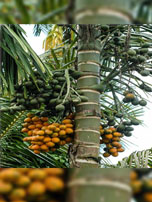SHAHEED KARTAR SINGH SARABHA AYURVEDIC MEDICAL COLLEGE & HOSPITAL
Affiliated to Guru Ravidas Ayurved University, Hoshiarpur Punjab
Affiliated to Guru Ravidas Ayurved University, Hoshiarpur Punjab

Botanical Name : Areca catechu Linn.
Family : Arecaceae
Introduction :
Latin name : Areca = old name from Malabar: catachu = derived from catechu, betle nut.
Names in different Indian languages :
English : Arecanut,Betel Nut tree
Hindi : Supari
Kannada : Adike
Malayalam : Kavugu,atakyamaram
Sanskrit : Puuga
Tamil : Kottai Paakku,Kamugu,pakkumaram
Telugu : Vakka,poka
Unani : Fufal,Chhaalia,Supaari
Synonyms :
Puuga, Puugi, Kramuka, Ghontaa, Guwaak, Ghorant
Morphology :
A tree 10-15 mtrs. high having no branches. Leaves – 1.5 to 2 mtrs.
Leaflets – 30 to 50 cms. long, slender and hairy.
Flower stalk – hard and branched
Fruits – appear in bunches. 3 – 6 cms, round, smooth and hard.
Green when unripe and yellowish red when ripes. Catachu is obtained after removing the hard rind. It bears flowers in autumn and fruits in spring.
A tree with a straight, slender, unbranched stem reaching 40 or 50 feet in height, about 20 inches in circumference, cylindrical, smooth, grey, marked at not distant intervals with regular rings of scars left by the fallen leaves.
Leaves (fronds) few (6—9), all terminal, spreading, very large and long, pinnate; petiole thick, concave above, convex beneath, passing below into a large smooth membranaceo-coriaceous sheathing base, and above into the convex angular rachis; leaflets (pinn) numerous, opposite, the lower ones often 3 or 4 feet long, the upper ones much shorter and usually combined together and truncate, broadly linear, acuminate, stiff, smooth, plicate at their attachment to the rachis in parallel folds.
Flowers unisexual, monncious, small, very numerous, sessile on the elongated, slender, smooth branches of the very much ramified inflorescence (spadix), without bracts, the male very numerous, the female much fewer, occupying the base of the branchiets; the whole spadix about 2 or 3 feet long, coming off below the leaves, and at first entirely enclosed between two large boat-shaped, coriaceous, blunt, striate, brownish bracts (spathe).
Male flowers :—Calyx deeply cut into 8 small, ovate, acute segments; petals 3, very much longer than the calyx, broadly ovate, acute, smooth, thick, striate, yellowish; stamens 6, filaments short, more or less combined into either 3 or a single fleshy central column, red, anthers dorsifixed, sagittate at the base, white; ovary represented by a small central fleshy body and three long reddish styles.
Female flowers :—Sepals 3, broadly ovate, fleshy, rigid, very thick in centre, thin at the margins, concave, persistent; petals 3, like the sepals but thinner, persistent. Stamens none or represented by a little hypogynous 6-toothed ring; ovary large, ovoid, acute, smooth, pale below, blackish-purple above, 3-celled, with a single ovule in each cell; stigmas 3, triangular, acute, papillose. Fruit 2—24 inches long, ovoid, somewhat tapering, surrounded at the base by the persistent perianth-leaves, smooth, orange-coloured when mature, pericarp (husk) at first soft, afterwards dry and composed of numerous, distinct, longitudinal fibres separating at the apex, 1-celled, with a single erect seed.
Seed globose-conical, about an inch in diameter, flattened on the base, testa very thin, closely adherent, yellowish, covered with a network of fine veins, and sending irregular processes into the substance of the endosperm almost to its centre, giving the latter a mottled appearance (ruminate); embryo small, quite at the base of the seed, erect, eudosperm very hard, white or pinkish, softer or often with a small cavity in the centre
Distribution & Habitat :
The Areca-nut Palm is found cultivated throughout the tropical parts of Asia, the hotter parts of Peninsular India, Ceylon, South China, the Philippine and other eastern Islands, and especially the Malay Archipelago, where it is considered to be originally indigenous. It is a well-known tree in India, being the most elegant Palm of that country. Like many other Palms, it flowers nearly all the year round. There is much variation in the form and size of the fruit, and Martius describes six varieties founded on its characters; in one form the husk is white
Chemical constituents :
Arecoline, arecaidine, guvacine, isoguvacine
Properties :
Rasa kashaya, madhur;
Guna : guru, ruksha;
Virya : sheeta;
Vipaka : katu;
Dosha kaphapiftanasak, trioshashamak – roasted with sand.
Karma :
Sedative, antimicrobial, antifungal, anthelmintic( not in human being) , antiviral, anti-inflammatory, antifertility, hypoglycaemic
Srotogamitva :
Dosha : Kaphaghna, pittaghna (tridoshaghna it roasted with sand).
Dhatu: Rakta (hemostatic, wound healing – externally), shukra (spermatorrhoea), majja (intoxicant).
Mala : Purisha (anthelmintic), mutra (polyuria).
Indication :
cough, piles, leucorrhoea,vomiting, dysentery,gout, burning sensation,dyspepsia,cephalgia,
Part used : Fruit
Dosage : Powder1-2 g
External uses :
Hemostatic and wound healing. Used for vata disorders. Tarnpoon dipped in its decoction is kept in vagina in leucorrhoea. Powder is sprinkled on wounds. Black powder of nut is used in tooth powder. Massage of medicated oil is useful in backache and vata diseases.
Internal uses :
It reduces blood pressure and is useful in bleeding disorders, vata disorders. stomatitis and bad breath. Over dose results in hyperperistalsis, griping pain and diarrhoea. In round and flat worms, 3 gm. betle nut + 2 gm. lemon juice (or 250 ml. of milk) given after a fast of 12 tol4 hours kills and expels the worms. Also useful in anorexia, loss of appetite, spermatorrhoea, leucorrhoea and polyuria.
